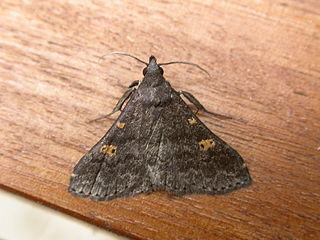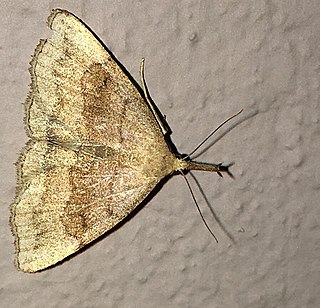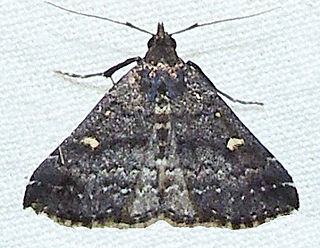
Hypena is a genus of moths in the family Erebidae. It was first described by Franz von Paula Schrank in 1802. These non-migratory moths overwinter as pupae and almost never estivate as adults.

Naarda is a large genus of erebid moths currently encompassing 108 species. Initially identified by Francis Walker in 1866, it is in the family Erebidae. Somewhat ruddy in appearance, this genus is distinguishable for its generally slender thorax and abdomen, and straight, porrect labial palpi. Most species are a light tan color, but shading can reach as deep as a charcoal, with muddy yellow, conspicuous reniform, orbicular stigmata featured on the forewings, sometimes reflected bilaterally superior.
Bicilia is a genus of moths of the family Crambidae.
Cryptobotys is a monotypic moth genus of the family Crambidae described by Eugene G. Munroe in 1956. Its only species, Cryptobotys zoilusalis, was described by Francis Walker in 1859. It is found in Cuba, Jamaica, Puerto Rico, Central America and the southern United States, where it has been recorded from Florida.

Zanclognatha is a genus of litter moths of the family Erebidae. The genus was erected by Julius Lederer in 1857.

Macrochilo orciferalis, the chocolate fan-foot or bronzy macrochilo, is a litter moth of the family Erebidae. The species was first described by Francis Walker in 1859. It is found in North America from Wisconsin to Nova Scotia, south to Florida and Texas.

Phalaenostola metonalis, the pale phalaenostola, tufted snout or pale epidelta, is a moth of the family Erebidae. The species was first described by Francis Walker in 1859. It is found in North America from British Columbia to Newfoundland, south to North Carolina, west to Missouri.

Renia factiosalis, the dark-banded renia or sociable renia moth, is a litter moth of the family Erebidae. The species was first described by Francis Walker in 1859. It is found from southern Canada to Florida and Texas.

Gesonia obeditalis is a species of moth of the family Noctuidae first described by Francis Walker in 1859. It is found from eastern Africa, the Seychelles, the Maldives and the Oriental tropics of India, Myanmar, Sri Lanka east to the Philippines, the Sula Islands and Australia. The adult moth has brown wings with a scalloped dark brown band near the margin. The hindwings are similar in pattern to the forewings but are a paler shade of brown.

Cydalima perspectalis or the box tree moth is a species of moth of the family Crambidae, first described by Francis Walker, the English entomologist, in 1859. Native to Japan, China, Taiwan, Korea, far-east Russia and India, it has invaded Europe; first recorded in Germany in 2006, then Switzerland and the Netherlands in 2007, Great Britain in 2008, France and Austria in 2009, Hungary in 2011, then Romania, Spain and Turkey. It has been seen in Slovakia, Belgium and Croatia.

Agrotera barcealis is a species of moth in the family Crambidae. It was described by Francis Walker in 1859. It is found in Sri Lanka, Sumatra, Borneo and Mysol.

Glyphodes pyloalis, the lesser mulberry snout moth, lesser mulberry pyralid or beautiful glyphodes moth, is a moth in the family Crambidae. It was described by Francis Walker in 1859. It is found in Iran, China, Japan, India, Indonesia (Sumatra), Sri Lanka, Taiwan, the Democratic Republic of the Congo, Equatorial Guinea, Mozambique and North America, where it has been recorded from Florida, Maryland, North Carolina, South Carolina and Virginia.
Herpetogramma stultalis is a moth in the family Crambidae. It was described by Francis Walker in 1859. It is found in Malaysia, India, Sri Lanka, China, Japan, Pakistan, Papua New Guinea and Australia, where it has been recorded from Queensland. In Africa, it has been recorded from the Democratic Republic of the Congo and Réunion.
Omiodes poeonalis is a moth in the family Crambidae. It was described by Francis Walker in 1859. It is found in the Democratic Republic of the Congo, Sierra Leone, Tanzania, the Chagos Archipelago, China, Indonesia, Sri Lanka, Japan and Australia (Queensland).

Hypenula cacuminalis, the long-horned owlet moth, is a moth of the family Erebidae. The species was first described by Francis Walker in 1859. It is found from the south-eastern United States west to Texas and Arizona.

Patania sabinusalis is a species of moth in the family Crambidae. It was described by Francis Walker in 1859. It is found in Australia, Cameroon, the Democratic Republic of the Congo, Kenya, the Seychelles, Somalia, Uganda, Zambia, Sri Lanka, India, Borneo, Java, Fiji, New Guinea, Samoa, the Solomon Islands, Taiwan and Japan.
Patania ultimalis is a species of moth in the family Crambidae. It was described by Francis Walker in 1859. It is found in Sri Lanka, Myanmar, Japan, Taiwan and Australia.
Hypolamprus bastialis is a moth of the family Thyrididae first described by Francis Walker in 1859. It is found in India, Sri Lanka, Indonesia, New Guinea and Australia.
Asciodini is a tribe of the species-rich subfamily Spilomelinae in the pyraloid moth family Crambidae. The tribe was erected by Richard Mally, James E. Hayden, Christoph Neinhuis, Bjarte H. Jordal and Matthias Nuss in 2019.











